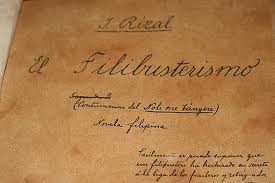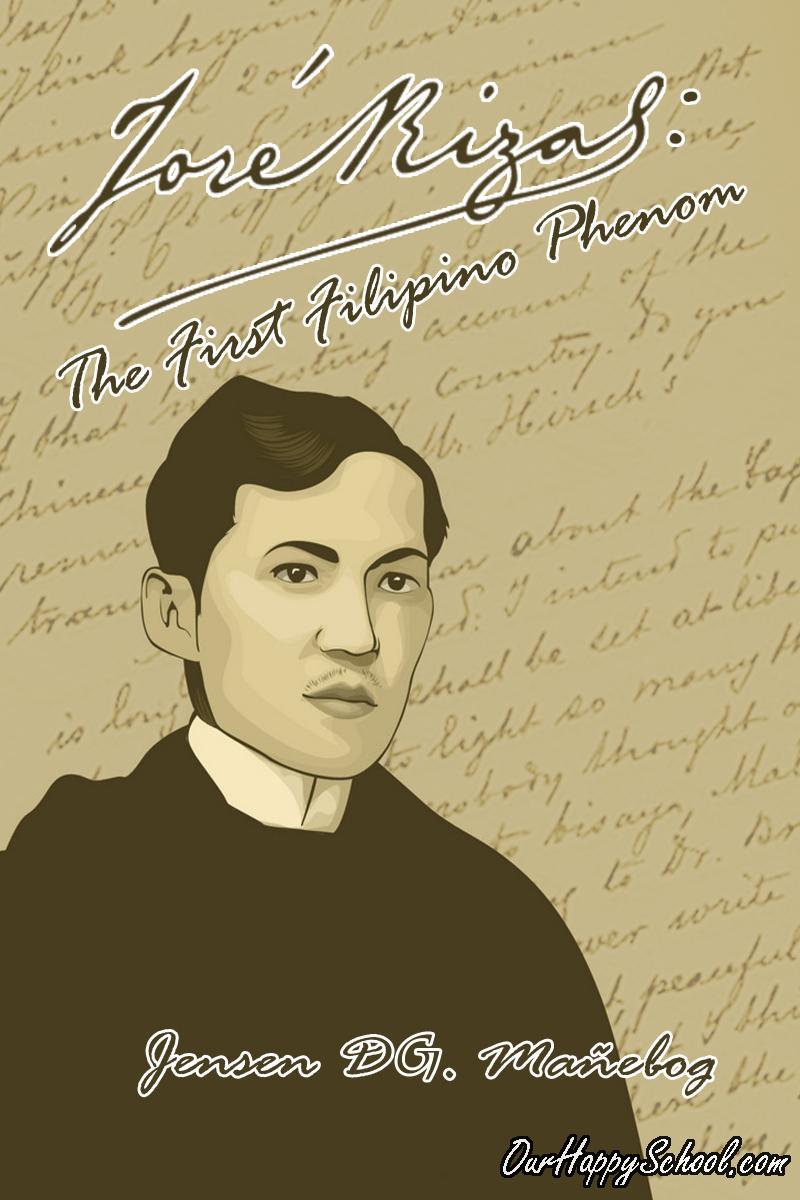Sponsored Links
The El Filibusterismo
© 2013 by Jensen DG. Mañebog
 ‘El Filibusterismo’ is Jose Rizal’s second novel written as the sequel of his ‘Noli Me Tangere’. Commonly nicknamed ‘El Fili’ or simply ‘Fili’, the novel was written also in Spanish. Its commonly known English alternative title is ‘The Reign of Greed’.
‘El Filibusterismo’ is Jose Rizal’s second novel written as the sequel of his ‘Noli Me Tangere’. Commonly nicknamed ‘El Fili’ or simply ‘Fili’, the novel was written also in Spanish. Its commonly known English alternative title is ‘The Reign of Greed’.
The writing and printing of Fili
Rizal started writing El Filibusterismo in October 1887 in Calamba during his first homecoming. The novel was thus written against the background of threats and oppressions he and his family suffered because of the Noli and the so-called Calamba agrarian trouble.
He continued working on it, making some revisions, in London in 1888. Rizal then went on to write the novel in Paris, and then in Brussels where distractions were less and the cost of living was cheaper. Being able to focus on finishing the book, Rizal had finally completed it by March 29, 1891 in Biarritz.
Jose Alejandrino, Rizal’s roommate in Belgium related that he was the one who canvassed printing press for El Fili. He delivered proofs and revisions to F. Meyer van Loo in Ghent. For his assistance, Rizal gave him the El Fili’s corrected proofs and the pen used in doing the corrections. Unluckily, these historical souvenirs were either lost or destroyed during the revolution (Ocampo, p. 111).
Alejandrino, who later became a general in the Philippine revolution, may have been the first person to read the novel aside from the author. However, the honor of being called ‘the savior of the Fili’ had gone to Valentin Ventura—Rizal’s friend who partially financed the novel’s publication. (Ventura’s steal of the title, one may argue, is another classic elucidation of the expression, “That’s what money can do.”)
Initially, Rizal financed El Fili’s printing by pawning his properties. In a letter to Jose Basa dated July 9, 1891, he related: “For the past three months I have not received a single centavo, so I have pawned all that I have in order to publish this book. I will continue publishing it as long as I can; and when there is nothing to pawn I will stop …”
Rizal’s next letter to Basa carried the sad news that the printing had to be suspended for lack of funds, and it was at this point where Valentin Ventura came into the picture. Having known Rizal’s predicament, Ventura offered him financial help.
In hindsight, we can assume that Ventura was bothered by his conscience, hence his generous monetary assistance for Rizal’s novel. Remember that Ventura was one of the Filipinos who promised to co-author Rizal’s proposed first book but ended up contributing nothing.
But even with Ventura’s help, Rizal found it necessary to fundamentally shorten the novel, erasing 47 whole pages from the 279-page manuscript to save expenses (Ocampo, p. 111).
Thus, the printed El Fili, which came off the press by the middle of September, 1891, turned out comprising only 38 chapters compared to the 64 of the Noli—contrary to his original plan to make a longer sequel.
For Ventura’s salvific act, Rizal gave him the novel’s original manuscript, a pen, and an autographed printed copy. In 1925, the Philippine government bought the El Fili manuscript from Ventura for a large sum of 10, 000 pesos (Zaide, p. 194). It is now being kept in the National Library.
Filibustero and Gomburza
The ‘Filibusterismo’ in the novel’s title is derived from the simpler term ‘filibustero’. Rizal defined the word (‘filibustero’) to his friend Ferdinand Blumentritt who encountered but did not fully comprehend the word in the ‘Noli’. Rizal thus explained in a letter:
“The word filibustero is little known in the Philippines …I heard it for the first time in 1872 when the tragic executions [of the Gomburza] took place. I still remember the panic that this word created. Our father forbade us to utter it, as well as the words Cavite, Burgos (one of the executed priests), etc ...
"The Manila newspapers and the Spaniards apply this word to one whom they want to make a revolutionary suspect. The Filipinos belonging to the educated class fear the reach of the word. It … means a dangerous patriot who will soon be hanged or well, a presumptuous man.”
The word ‘filibustero’ thus contextually means subversive, dissident, revolutionary, seditious, insurrectionary, and treasonous. Fittingly, Rizal dedicated the book to the memory of the Gomburza, the three Filipino patriotic priests who were accused of being ‘filibustero’ and thus executed.
In his dedication, Rizal fearlessly declared his conviction that the Spanish officials’ treatment of the priests’ case was unjust “as [their] complicity in the Cavite Mutiny is not clearly proved”.
The dedication partly reads: “To the memory of the priests, Don Mariano Gomez (85 years old), Don Jose Burgos (30 years old), and Don Jacinto Zamora (35 years old). Executed in the Bagumbayan Field on the 28th of February, 1872 … I have the right to dedicate my work to you as victims of the evil which I undertake to combat…”
Rizal however made mistakes in indicating the ages of the priests and the date of their execution. During their martyrdom on the 17th (not 28th) of February, 1872, Gomez was then 73 (not 85), Burgos was 35 (not 30) and Zamora was 37 (not 35). Like many other students today (especially men), Rizal was perhaps not that good in memorizing historical details like dates and ages.
The foreword of the Fili was nonetheless addressed “To The Filipino People and Their Government”. The original manuscript also includes a “warning” and an “inscription” on the title page written by the author’s friend, Ferdinand Blumentritt.
Noli vs. Fili
Noli and Fili Stolen
In Rizal’s time, the Permanent Commission of Censorship recommended the absolute prohibition on the importation, reproduction, and circulation of the Noli. The copies of the Fili, on the other hand, was destroyed by Customs in Manila upon shipment to the Philippines. The rare surviving copies of the novels were secretly purchased and “according to one friend of the family, had to be read in the smallest, most private room in the house—the toilet” (Ocampo, p. 108).
That was the fate of the first edition of Rizal’s novels. But that is nothing compared to what happened to their original manuscripts about 70 years after their publication.
The original manuscripts of the Noli and Fili (along with that of the poem ‘Mi Ultimo Adios’) were stolen from the National Library on the evening of December 8, 1961. After some days, the thieves who outsmarted the building’s sleepy guards sent a ransom note “made of newspaper cutouts” to the Jose Rizal National Centennial Commission (JRNCC) (Ocampo, p. 148). The robbers demanded 1.4 million pesos for the return of the original texts, else Rizal’s handiworks would be burned.
To summarize the ‘historic robbery’, the then Education Secretary Alejandro ‘Anding’ Roces personally met with the burglars and, after some various negotiations, had retrieved the documents without paying a single centavo. The manuscripts were returned on installment basis—the ‘Ultimo Adios’ during the first meeting, the ‘El Fili’ on the next negotiation, and lastly, the ‘Noli’. There was a time when the demanded ransom was reduced to 100,000 pesos and then to 10,000 pesos (Ocampo, p. 148). But recognizing perhaps that they would get nothing from the government, the robbers ultimately settled on returning the expensive documents, free of charge.
Many still find this ‘charge-free return of the manuscripts’ strange and mind-blowing. But the following additional details about the story could perhaps shed light on the account.
During the negotiations, one of the burglars related to Roces that on the night of the robbery, “the Rizal manuscripts suddenly became heavy as a cavan of rice”. The thief thus exclaimed, “The manuscript must be holy or haunted!” (Ocampo, p. 148). One robber even claimed that he read Rizal’s handwritten novels and described the feeling, “Ang sarap basahin, kinikilabutan ako!” (Ocampo, p. 148). It’s remarkably funny to note however that the thief did not understand Spanish! Nonetheless, these indicate that the stealers were probably bothered by their conscience, hence the consent to just send back the national hero’s works.
Anding promised not to identify the robbers or to be a witness against them in court. Thus, the hilariously controversial thieves were never known.
The legacy of Noli and El Fili
For fearlessly depicting the corruptions and abuses by the Spanish clergy and colonial government during the Spanish regime in the Philippines, the two novels arehistorically very significant. Basically a social sketch of the country then, the Noli and Fili reveal the true setting and condition of the Filipino society in the era.
As essential source of sociological and anthropological studies, the books provide rich insights into the culture of the 19th and 20th century Philippines. Their realistic depictions expose a conflicted colonial society seriously split between the oppressors and the suffering local slaves. The novels’ characters mimic the various elements and types of individuals in that society. Furthermore, they show favorable positive traits of the natives then like the sense of gratitude, the fidelity of women to their loved ones, and the yearning for freedom and equality.
For their explicit portrayal of what the locals really wished for their country, the books were instrumental in forming the Filipino’s (Indios) sense of national identity. Indirectly but significantly, the novels influenced the revolution led by the Katipunan as they inspired Andres Bonifacio and other revolutionaries in their cause.
Rizal was arrested, exiled to Dapitan, and ultimately executed in 1896 based principally on his writings. In 1956, the Philippine Congress passed the Rizal Law (Republic Act 1425) requiring all levels of Philippine schools to teach as part of the curriculum the hero’s two novels. (Read: Republic Act 1425 Rizal Law (Its History and Important Provisions))
Originally written in Spanish, the Noli and the Fili had been translated into various languages like Filipino, English, German, French, Chinese, and other Philippine languages. In 2007, an English version of Noli Me Tangere was released to major Australian book stores. It was published by Penguin Books Classics as part of the publication’s commitment to publish the major literary classics of the world ... continue reading
Copyright © 2013-present by Jensen DG. Mañebog
Jensen DG. Mañebog, the contributor, is a book author and professorial lecturer in the graduate school of a state university in Metro Manila. His unique e-books on Rizal (available online) comprehensively tackle, among others, the respective life of Rizal’s parents, siblings, co-heroes, and girlfriends. (e-mail: jensenismo@gmail.com)





